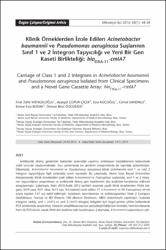Carriage of class 1 and 2 integrons in acinetobacter baumannii and pseudomonas aeruginosa isolated from clinical specimens and a novel gene cassette array: bla(OXA-11)-cmlA7

View/
Access
info:eu-repo/semantics/openAccessDate
2014Author
Mengeloğlu, Fırat ZaferÇiçek, Ayşegül Çopur
Koçoğlu, Esra
Sandallı, Cemal
Budak, Emine Esra
Özgümüş, Osman Birol
Metadata
Show full item recordCitation
Mengeloglu, F.Z., Cicek, A.C., Kocoglu, E., Sandalli, C., Budak, E.E., Ozgumus, O.B. (2014). Carriage of class 1 and 2 integrons in acinetobacter baumannii and pseudomonas aeruginosa isolated from clinical specimens and a novel gene cassette array: bla(OXA-11)-cmlA7. Mikrobiyoloji Bulteni, 48(1), 48-58.Abstract
The dissemination of antibiotic resistance genes between bacteria leads to serious problems in the treatment of infectious diseases. It has been shown that resistance genes can also be carried by the integrons. There are limited studies regarding the carriage of class 1 and 2 integrons in Acinetobacter baumannii and Pseudomonas aeruginosa clinical strains in Turkey. the aims of this study were to investigate the carriage rates of class 1 and class 2 integrons in A.baumannii and P.aeruginosa strains isolated from clinical samples in Abant Izzet Baysal University Hospital, and to characterize the antibiotic resistance gene cassettes in these integrons by sequence analyses. A total of 137 strains (77 A.baumannii and 60 P.aeruginosa) isolated from various clinical specimens (56% were sputum, 19% wound, 11% urine, 11% blood, 3% catheter), between March 2010-December 2012, were included in the study. the identification and antibiotic susceptibility tests of the isolates were performed by Vitek 2 Compact (bioMerieux, France) and BD Phoenix 100 (Becton Dickinson, USA) systems. the presence of integrons were screened by PCR method using specific primer pairs targeting class 1 (intil1) and 2 (intl2) integrase regions. All the samples that revealed integron amplification were subjected to DNA sequence analysis, both in the forms of cloned products and PCR amplicons. in the study, the highest susceptibility rates were found against colistin (96%) and tigecycline (78%) in A.baumannii, and against piperacillin/tazobactam (97%) and piperacillin (93%) in P.aeruginosa isolates. the highest resistance rate was determined for piperacillin/tazobactam (95%) in A.baumannii strains. the presence of intl1 gene was detected in 33% (26/77) of A.baumannii and 10% (6/60) of P.aeruginosa isolates. When variable regions in intl1 positive strains were amplified by PCR, eight (8/77, 10%) A.baumannii and three (3/60, 5%) P.aeruginosa strains were found to harbor antibiotic resistance gene cassettes. Intl2 gene was not detected in any of the isolates. Resistance to piperacillin/tazobactam, ceftazidime, cefepime, ceftriaxone and ampicillin/sulbactam was detected as the common resistance pattern in all integron-positive A.baumannii strains, whereas resistance to ceftazidime, gentamicin and ciprofloxacin was the common pattern in all integron-positive P.aeruginosa strains. DNA sequence analysis of variable regions of integrons indicated that two separate gene cassette arrays (aacC1-aadAl and aac(3)-1) were carried by A.baumannii strains, and two types of gene cassette arrays (bla(OXA-30)-aadA1 and bla(OXA-11)-cmlA7) were carried by P.aeruginosa strains. To our best knowledge, this is the first report of the gene sequence of bia(OXA-11)-cmlA7 defined in an integron gene cassette of P.aeruginosa.

















